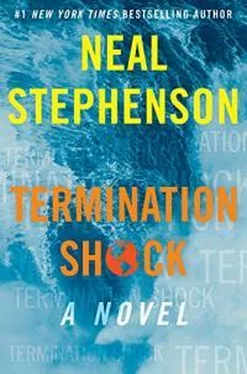So they’d known for days that they were going to have to close the great gates of the Maeslantkering. Across the sea, the same precaution was being taken at the Thames Barrier below London. It was only a question of when the linked computer models that ran the thing would decide to pull the trigger. For along with all the other superlatives that characterized that system, it was also the world’s largest robot.
They had a pretty good idea of when it would happen. And once it started, it took a while. Advance notice had gone out to mariners so that they would have time to move their vessels in or out of the gates before they swung shut. Saskia wanted to be there for at least part of it, as the capstone of her disaster preparedness jihad. So she went out a bit early and, to kill time, did an informal drive-by inspection of the nearby Maasvlakte.
This was an artificial peninsula that protruded, wartlike, from the nearby coast into the North Sea. Its purpose was to support an immense container port. Back in the age of sail, oceangoing ships had been able to glide all the way up to the ancient center of Rotterdam, some twenty-five kilometers inland. But as centuries had passed and ships had gotten bigger, they’d tended to drop anchor farther downstream. Accordingly the port had grown in that direction. The culmination of all that had been the creation of this Maasvlakte, an anchorage that could be reached without entering the waterway at all. It was thus capable of servicing the very largest container ships in the world: absurdly enormous things, double the width of the biggest ship that could fit through the Panama Canal, that boggled Saskia’s mind whenever she came out here to look at them. It was the place where the economy of China made a direct umbilical connection to Europe. The ships were two dozen containers wide and drew twenty meters of water when fully loaded. Some of them, fresh in from Asia, would unload part of their burden here just so that they would ride higher in the water, making it possible for them to move on to smaller and shallower European ports.
The Maasvlakte comprised several docks. One of them was named after Princess Frederika—a nakedly political move on someone’s part, and yet it had given her a proprietary attitude about the place. There was an access road where you could go and park without getting in the way of port traffic, so that was where her three-car caravan went, just to see the sights and kill a little time before they got the go-ahead to drop in at the Maeslantkering, which was just a few kilometers upstream.
The Maeslantkering’s status as the largest robot in the world seemed less exceptional when viewed from the Maasvlakte. The entirety of the Port of Rotterdam was a giant machine. Not that it didn’t have plenty of greenery—you could hardly stop green things from flourishing here—but the soil in which it grew was just another component of the machine, graded and shaped and tamped just so to channel water or to support unbelievably heavy objects. The greenery had a purpose too: to keep important dirt from washing away. Decades ago one might have seen long strips of grass running parallel to the roads, railways, canals, and pipelines that serviced the docks. Those were still there, but they had all been turned into picket lines of wind turbines, all of which today were facing into the winds coming down out of the north as harbingers of the storm and spinning around as rapidly as their robot control systems deemed prudent. For space on the skyline they competed with looming queues of container cranes, parked oil rigs, and refinery stacks. These were arranged in layers that were interleaved at various distances as far as one could see, eventually blurring into a silvery mist.
The operations of the Princess Frederika Dock and its siblings around the Maasvlakte were as automated as technology and unions would allow. She could still remember cutting the ribbon on this thing as a teenager. One of the senior executives who’d been allowed to have lunch with her had reminisced about his former job deciding which container should be placed where on the cargo ships of his day: how to be sure that the load was balanced, and that it would remain balanced while the ship was being loaded or unloaded, while keeping in mind that the vessel might have to make several stops to discharge all its containers. He’d done it with index cards. The courtiers in attendance had tried to shut the poor man up, fearing that the princess would be bored, but she’d found it fascinating. Nowadays, of course, it was all done by software. When a big ship from China pulled into the Yangtze Canal—the deepest berth of all the Maasvlakte, the one closest to the sea—the over-reaching cranes that plucked the boxes from it and placed them on trucks or railway cars were robots that knew exactly what was in each container and where it needed to go. And the trucks themselves, shuttling containers to and fro, were for the most part driverless. Saskia, who had at one point in her young life been subjected to a battery of tests whose purpose was to find out whether her eccentric interests were a result of being on the autism spectrum, loved to just come here and watch the machine run, somewhat as a monarch of another era might have amused himself playing with his tin soldiers.
Things were a bit different today, though, because there was some concern that some areas of the Maasvlakte might get swamped by the storm surge, and so efforts were underway to move vulnerable stuff inland. And on the water, ships were making efforts to get out of town. In the middle of the Yangtze Canal loomed Andromeda , one of a fleet of Chinese container ships that vied for the honor of being the largest in the world. She’d apparently wound up her business ashore and was now being nudged away from the quay by tugboats. In old-school ports it might have required some hours before she could get underway, but here at Maasvlakte she already had a straight shot to open, deep water and needed only push down on the gas pedal, as it were. A couple of launches were shuttling back and forth between the shore and a pilot’s door on her flank, presumably ferrying last-minute personnel and necessaries that had been left behind in the rush to get out ahead of the storm.
“I’m going to go survey the disposition of the enemy forces,” Saskia announced and hiked off in the direction of what appeared to be a long low mound of gray sand running in a straight line along one edge of the port and separating it from what looked to be absolute nothingness on the other side. Any Dutch person would immediately recognize it as a dike, although most dikes were covered with grass. Other than a couple of lonely, opportunistic shore birds, this thing was as dead and colorless as the surface of the moon. Guessing her intent, the security team scrambled out of their cars and ran to catch up.
It started as a low flat beach of fine wet sand, then suddenly got steeper and coarser, with a vaguely scalloped shape that probably showed where a grab dredger had opened its clam shell bucket to dump huge gobs of muck. This was new work that hadn’t yet settled to its natural angle of repose. Saskia helped that process along in a small way by wading and staggering up over knee-high mini-cliffs and touching off small avalanches. The levee was higher than it looked from a distance, which on a day like this was reassuring. Eventually she got to the point where she could see over the top, though. And what she could see—“The enemy forces”—was a whole lot of nothing. Visibility was cut off by mist at a distance of maybe a kilometer. The gray sea was churning and heaving, but there weren’t a lot of breakers coming in against this steep artificial shore. Those that did attack it were flicked away by the dike’s outer armor. For, soft as it was on its inner slope, the side facing the sea was another matter. The smallest and lightest objects that met the eye there were reinforced concrete cubes two and a half meters on a side. And, as had been explained to her at a level of detail that would have rendered most royals catatonic, this was only the uppermost layer of an engineered system that reached deep below the water.
Читать дальше

![Нил Стивенсон - Криптономикон [litres]](/books/23868/nil-stivenson-kriptonomikon-litres-thumb.webp)








![Нил Стивенсон - Лавина [litres с оптимизированной обложкой]](/books/414066/nil-stivenson-lavina-litres-s-optimizirovannoj-ob-thumb.webp)
